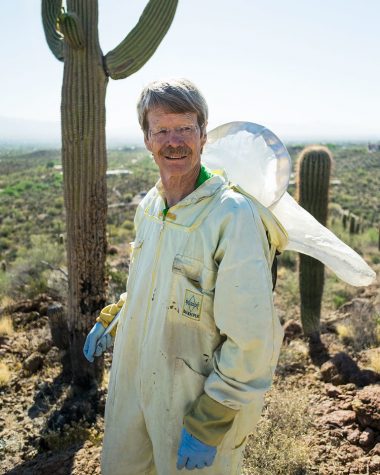Justin O. Schimidt: The King Of Sting
Stung by 150 Insect and still counting!
December 3, 2018
Justin O. Schmidt is a Biologist at the Southwest Biological Institute has been stung by 150 species of insects and has been stung overall about 1,000 times. Schmidt is no masochist, he just happens to get stung by his specimens he collects for experiments, studies, and for his Schmidt Sting Pain Index. According to the Guardian Schmidt came up with the idea of the pain index when he was doing field work as a chemical ecologist and collecting species for him to study their mechanisms, which made it pretty easy to get stung. Schmidt realized that while the insect’s venom could be analyzed it was very difficult to differentiate the pain between different pain each insect caused, which he saw as essential to better understanding why and how certain types of stings evolved.
 The Guardian states that Schmidt’s theory was that insects in areas with more predators had to have more potent stings. He tested this by making the pain index, where the levels of discomfort from a sting is measured from a scale one to four (one is lowest and four is highest). Whenever Justin got stung he would rate the pain then write a quick description of the pain. An example of a level one sting would be the sweat bee, which he described as “ Light, ephemeral, almost fruity. A tiny spark has singed a single hair on your arm.” The two scale includes the yellow jacket wasp. “ Hot and smokey almost irreverent.” The red harvester ant gets a three “ Bold and unrelenting. Somebody is using a drill to excavate your ingrown toenail.” A four would be a tarantula hawk which Schmidt describes as “Blinding, fierce, shockingly electric. A running hair dryer has been dropped in your bubble bath. A bolt out of the heavens. Lie down and scream.” When Schmidt was developing his scale he realised humans don’t think in terms in numbers says the, but rather in images and art, so he tried to make his scale more of an artistic equivalent.
The Guardian states that Schmidt’s theory was that insects in areas with more predators had to have more potent stings. He tested this by making the pain index, where the levels of discomfort from a sting is measured from a scale one to four (one is lowest and four is highest). Whenever Justin got stung he would rate the pain then write a quick description of the pain. An example of a level one sting would be the sweat bee, which he described as “ Light, ephemeral, almost fruity. A tiny spark has singed a single hair on your arm.” The two scale includes the yellow jacket wasp. “ Hot and smokey almost irreverent.” The red harvester ant gets a three “ Bold and unrelenting. Somebody is using a drill to excavate your ingrown toenail.” A four would be a tarantula hawk which Schmidt describes as “Blinding, fierce, shockingly electric. A running hair dryer has been dropped in your bubble bath. A bolt out of the heavens. Lie down and scream.” When Schmidt was developing his scale he realised humans don’t think in terms in numbers says the, but rather in images and art, so he tried to make his scale more of an artistic equivalent.
His hypothesis on sting was proven correct: the higher the danger surrounding a colony the more pain and the higher potency of the venom the insect can inflict. On Schmidt’s scale he uses the honey bee as a reference point as a way to set a control, because almost everyone has been stung by one and if Schmidt and a person can both agree that a bee is a two then it is easier to rate stings that hurt more or less than a honey bee sting. Schmidt is still updating his scale too if he is stung by an insect he has never encountered before he at first acts like anyone else would- cursing more than is necessary and then sitting down and taking notes.


